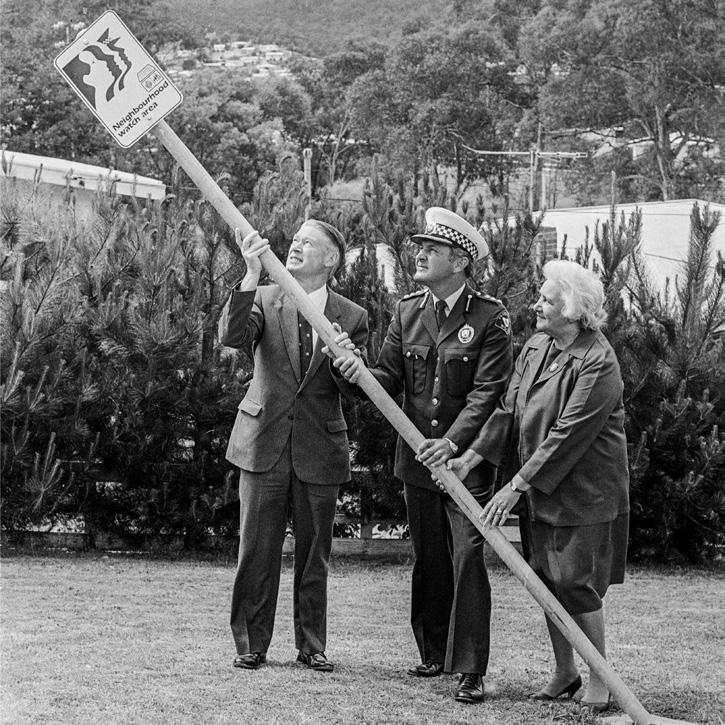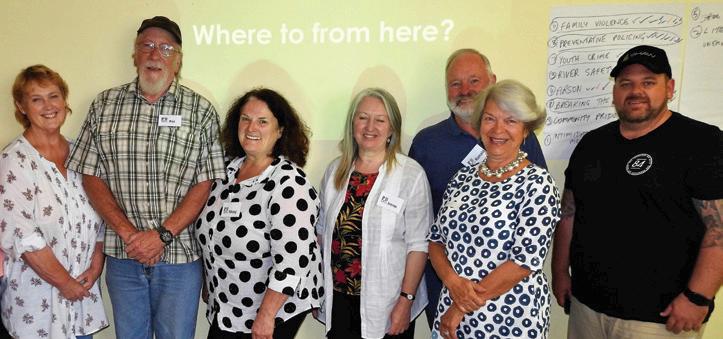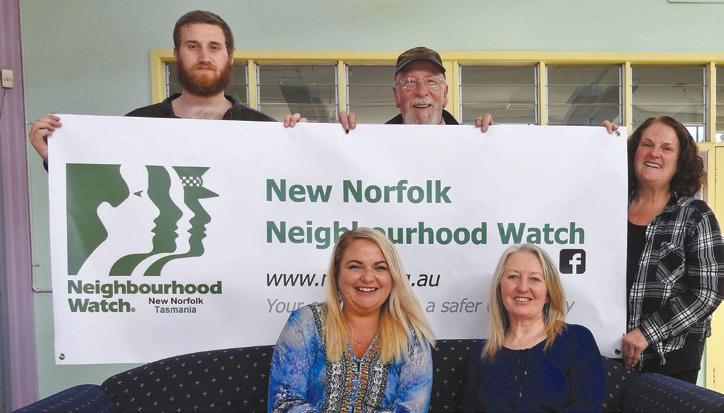
9 minute read
Tasmania
NHW TAS
TASMANIA
Focus on Spring Bay Neighbourhood Watch
The original and fundamental purpose of Neighbourhood Watch (NHW) is to help prevent crime. Although community-led, its ongoing strength and validity is through the partnership it enjoys with every Police Service in Australasia.
Being a volunteer movement, NHW often needs to be strategic in the activities it undertakes. This article is about the benefits of those partnerships at the local and individual level and how public safety and connectedness are combined with crime prevention to form the three platforms on which we stand today. This focus on Spring Bay is intended to reinforce those values from a grass roots example.
Triabunna and Orford are twin towns on the east coast of Tasmania about eight kilometres apart and one hour’s drive from Hobart. In 1999 each town had its own one officer police station to service a combined, permanent population of 2,000 people. This number tripled during the holiday seasons, thanks to the excellent fishing and beaches on offer in that part of the world. Although the area had a low crime rate, the newly transferred officer to Triabunna, Senior Constable Michael Fama brought with him some prior knowledge and experience of the benefits of Neighbourhood Watch.
Not long after arriving in the town, Michael was approached by some youths asking when their skate park would be built.
Members of the Spring Bay NHWT group in 2006
Subsequent enquiries revealed that the local council would finance the park if an organisation would take responsibility for building it.
The history record shows that one hot Saturday morning, local men and women screened some thirty metres of sloppy cement to complete the build which is still in use today. As a result, Spring Bay Neighbourhood Watch was up and away and is still going strong in 2020.
NHW Spring Bay pride themselves on seeing a problem and doing something about it. The following examples have proven to be simple but extremely worthwhile initiatives for their communities:
The tried and true fridge magnet is often a good way to start broadcasting a message. The NHW Spring Bay fridge magnet was an early project with a very specific message, to supply every home, holiday residence and business in both towns with all emergency phone numbers of their areas ‘first responders’. 2,000 were produced and given out free of charge.
Because of the rubbish strewn along their local highway, the group became a part of the Tasmanian ‘Adopt a Highway’ project. In their first clean-up they collected 90 bags of rubbish for the local council to cart away.
A serious problem for country areas was identified by the local ambulance officers who were having difficulty locating homes, particularly at night.
Many addresses did not have reflective house numbers – some houses had no numbers at all.
The group took up this challenge and garnered some generous assistance to provide 270 homes with new standardised reflective numbers at no cost. This article provides a snapshot of how NHWT came into existence and how it is doing business now compared to when it started in the previous century. It was in 1985 that Dr Michael Readett, a Hobart dermatologist and local government councillor, teamed up with ABC personality Sue Becker to promote the value of establishing Neighbourhood Watch (NHW) in Tasmania. Dr Readett had been so impressed by the success of NHW in combatting neighbourhood crime, particularly housebreaking in More recently the Spring Bay group supported a project to provide security cameras at the main intersection in Triabunna. With generous assistance from local businesses and organisations, two high quality colour cameras were installed at the main intersection to deter anti-social behaviour and improve town security by linking to the existing camera network.
Perhaps the pièce de résistance was their latest project to purchase and install a defibrillator in the local hall. This acquisition supports the Ambulance Tasmania (AT) ‘Early Access to Defibrillation’
Program. Research indicates that when a defibrillator is available (and they are shockingly easy to use) the cardiac arrest survival Victoria, that he was determined to introduce the concept into Tasmania. As a result, a public meeting was arranged to be held in the Lindisfarne Masonic Hall and according to people present at the time, the venue was packed; and those present were suitably impressed with the eloquent presentation from Dr Readett and the dynamic, dramatic and entertaining enthusiasm of Sue Becker. The audience on this evening also included the then Commissioner of rate can be as high as 80%. What a great contribution to the Spring Bay community.
In 2008 Michael Fama retired from the Tasmania Police Force, but stayed on in the Spring Bay Community where he is still an active member of Neighbourhood Watch. The reality is that volunteering is rewarding and as NHW members know it is great to reflect on the projects you have been involved in, the friendships you have made and the benefits your contributions have made to society.
There are always projects that can make a difference in communities and NHW is a realistic vehicle for doing just that. The Spring Bay experience is but another example
Neighbourhood Watch Tasmania – 35 Years On
In 2021, Neighbourhood Watch Tasmania (NHWT) will celebrate 35 years of supporting Tasmanian Police and local communities with crime prevention initiatives; public safety projects and promoting neighbourliness (connectedness) by building community relationships.
of things we can do if we want to. Tasmania Police, Mr Max Robinson, who spoke on the proposal; the Divisional Police Inspector (later to become Assistant Commissioner), John Woolley; and Senior Constable Ray Curran who at that time was the Officer in Charge of the Crime Prevention Bureau.
The public were unanimous in their support for the concept and this persuaded Commissioner Robinson to both authorise and support the establishment of NHW in Tasmania (NHWT).
John Woolley recalls that he was duly anointed that very same evening as, for want of a better title, the initial Tasmania Police NHWT project manager.
Of course, the process of moving a concept to a practical and workable reality, does not happen overnight and not without significant consultation and planning. It was not until 1986 that the first official Neighbourhood Watch Area at Risdon Vale was established.
The photo of Dr Readett, Inspector Woolley and local NHW Coordinator Mrs Edith Guy, which was provided courtesy of The Mercury Newspaper, is an important historical record of the first NHW sign being erected in Tasmania.
It is a credit to those NHWT pioneers that the organisation grew progressively and with a sound governance structure, that has ensured its value and continuing contribution to local communities across the state to this day.
During the 1980s and 1990s NHW exploded across Tasmania with each Watch having its own local committee, which fed into an area committee, district committees and then a state committee. The records of those early days indicate that it received generous financial support from Commercial Union Insurance and by 1993 Sergeant Scott Brooks had been appointed as the first Tasmanian Police State Coordinator for Neighbourhood Watch.
At its peak, long-term members report there were in excess of 160 Watches spread throughout the state. The proliferation of Neighbourhood Watch signs across Tasmania are a testament to its spread and a potential project for the future could be to geo-locate them all.
With the benefit of technological advances NHWT has evolved and adapted over time. Although we still boast 30 traditional Watches in Tasmania, we now
Dr Readett, Inspector Woolley and local NHW Coordinator Mrs Edith Guy erecting the first NHWT sign in Tasmania

also accommodate individual members and virtual groups that use social media as the preferred method for communicating and sharing information across their communities.
An important aspect of the NHWT evolution has been the increasing emphasis on community connectedness. Partnerships have been forged with many service organisations and community groups as these relationships only improve coordination and increase the number of workers for functions and events designed to support the communities in which we live and work. These relationships and the increased use of technology are examples of how NHWT is moving with the times and continuing to make a meaningful contribution to community safety and wellbeing. Of course, the cornerstone partnership for NHWT continues to be with Tasmanian Police and the importance of this relationship is enshrined in a Memorandum of Understanding between our two organisations.
Planning is now underway to celebrate the 35th anniversary of NHWT in 2021 and will be used as a springboard for enhancing community safety and connectedness well into the future.
Developing an e-Hub for the Derwent Valley
The New Norfolk Neighbourhood Watch (NNNHW) is located in the Derwent Valley and having been established in 2018, is one of the newer groups in Tasmania.
To make sure that any projects or activities were designed to meet the needs of their community, the group undertook a structured approach to informing themselves.
They achieved this through community consultation, which culminated in a planning workshop in March 2019. The strongest theme to emerge in that process was the need for increased collaboration, co-ordination and sharing of information between support services and the Derwent Valley community.
With this information and some tech savvy members on the team, the concept of the Derwent Valley Community e-Hub started to take shape. The idea was that the e-Hub would be a one-stop, comprehensive and multi-layered database for the Derwent Valley community. Here they can access the support they need in a timely and efficient manner.
A number of service organisations quickly gave their support to the proposal which envisions a presence on the e-Hub for information providers and community servicefocused programs, emergency services, volunteer groups, clubs, special interest groups and other event organisers.
A major benefit of the e-Hub is that it will reduce the duplication of services and facilitates better
New Norfolk NHW Workshop, March 2019

collaboration between the support networks already operating within that community.
Of course, projects like this must have vision and leadership, but more specifically – money! NNNHW have been successful in raising some funds of their own – but a project like this cannot be brought to fruition on only passion and good-will.
Some grant applications were unsuccessful but the group were not deterred, as their proposal was based on sound research and a desire to make a real difference in their community. Hardware support has been provided by the Derwent Valley Council, and the Online Access Centre will provide facilities for future training purposes.
Yes, the group has had disappointments and knock-backs along the way, however, with the help of web-designer Andrew Lockman & Associates providing significant in-kind contributions to the build; and a recently awarded funding grant from Neighbourhood Watch Tasmania, the project is well on the way to delivery.
Visit the website http://nnnw.org.au/










